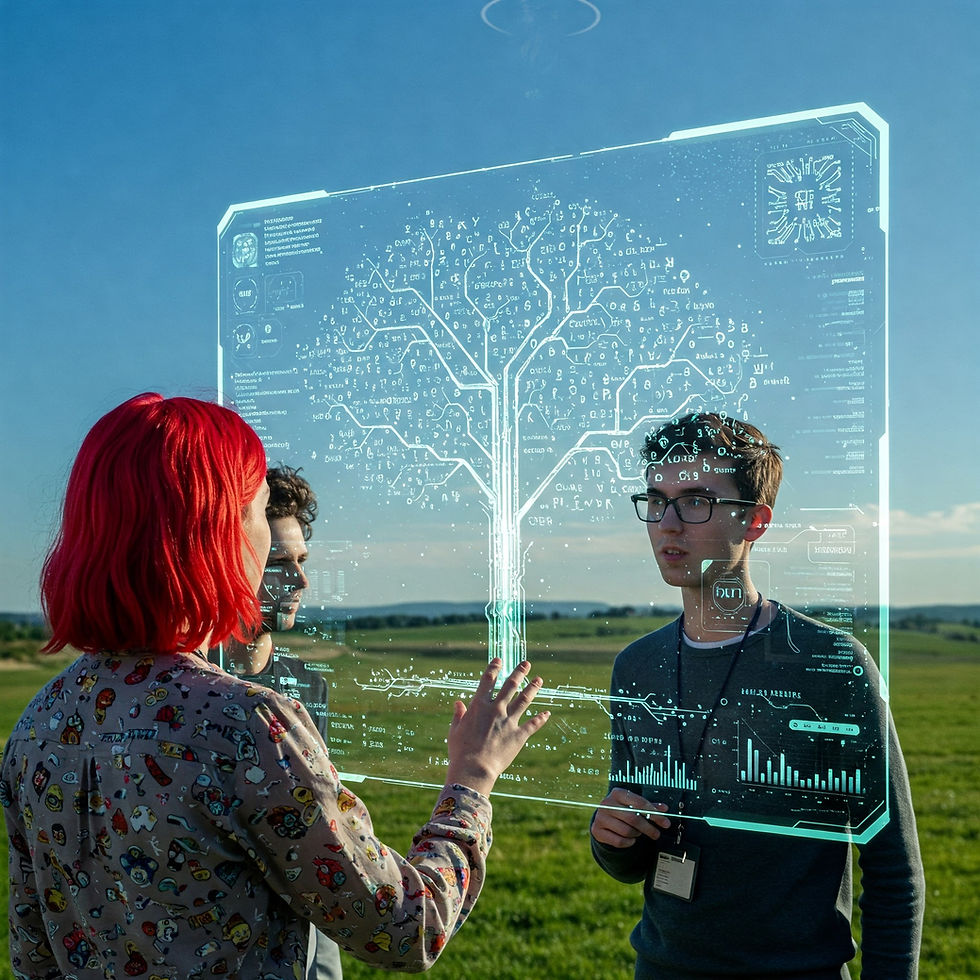Charting the Future of AI in Linguistics and Translation
- Tretyak
- 6 days ago
- 5 min read

Artificial Intelligence (AI) is already revolutionizing the fields of linguistics and translation, but the current state is merely a prelude to a future teeming with even more groundbreaking possibilities. We are on the cusp of a quantum leap in language technology, where AI transcends its role as a tool and becomes a dynamic partner in our quest for universal understanding. Let's explore some key future directions, delving into the nuances and transformative potential of each:
1. Multilingual AI: The Genesis of a Global Lingua Franca
What it is (Expanded): Current AI models often excel in specific language pairs, but the future beckons the development of truly multilingual AI systems. These systems will possess the capacity to understand, generate, and translate text and speech across dozens, or even hundreds, of languages simultaneously, operating with a level of fluency and contextual awareness that surpasses current capabilities.
Impact (Expanded): The emergence of multilingual AI would have a profound impact on society, fostering unprecedented levels of global communication, collaboration, and cultural exchange. This would lead to:
Elimination of language barriers: Seamless communication in international business, diplomacy, education, and personal interactions.
Democratization of information: Access to knowledge and resources for individuals regardless of their native language.
Preservation of linguistic diversity: AI tools could help document, analyze, and revitalize endangered languages, ensuring their survival in the digital age.
Examples (Expanded):
Universal Translation Interfaces: AI systems integrated into virtual reality environments, allowing individuals to communicate in real-time with others speaking different languages, with AI acting as a dynamic and invisible interpreter.
Multilingual Knowledge Graphs: Vast AI-powered databases that connect information across languages, enabling cross-lingual search and knowledge discovery.
AI-driven language education platforms: Personalized learning experiences that adapt to individual needs and facilitate the acquisition of multiple languages simultaneously.
2. Context-Aware AI: The Algorithmic Empath
What it is (Expanded): While current AI models are improving in their ability to understand context, the future demands a level of sophistication that approaches human-like comprehension. This involves equipping AI with the ability to:
Grasp Social and Cultural Nuances: Understanding the subtle social cues, cultural references, and historical contexts that shape communication.
Decode Emotional Intent: Accurately interpreting the emotional tone, sentiment, and underlying intentions behind spoken or written language.
Reason about the World: Possessing common-sense knowledge and the ability to make inferences about the real-world situations described in language.
Impact (Expanded): Context-aware AI will lead to more nuanced, accurate, and culturally appropriate translations, avoiding misunderstandings, misinterpretations, and potential offense. This will enhance:
Cross-Cultural Communication: Fostering empathy and understanding in interactions between people from different cultural backgrounds.
Effective Marketing and Advertising: Creating messaging that resonates with target audiences in diverse markets.
Natural Language Interaction: Enabling more natural and intuitive communication with AI-powered virtual assistants and chatbots.
Examples (Expanded):
AI that can distinguish between sarcasm, irony, and genuine statements.
Translation systems that adapt their style and tone to the genre and purpose of the text (e.g., formal vs. informal, technical vs. literary).
AI that can understand and respond appropriately to humor and wordplay.
3. AI-Powered Language Preservation: The Digital Archivist of Linguistic Heritage
What it is (Expanded): Many of the world's languages, particularly indigenous and minority languages, face the threat of extinction. AI offers powerful tools for documenting, analyzing, and revitalizing these languages, ensuring their survival for future generations. This includes:
Automated Documentation: Creating digital archives of spoken and written language, including audio recordings, transcriptions, and grammatical analyses.
AI-Generated Language Learning Materials: Developing interactive and personalized language learning tools, such as apps, games, and virtual reality experiences.
AI-Facilitated Community Engagement: Creating platforms that enable speakers of endangered languages to connect, share resources, and preserve their cultural heritage.
Impact (Expanded): AI-powered language preservation can:
Empower Indigenous Communities: Giving them control over their linguistic heritage and providing tools to maintain their cultural identity.
Promote Linguistic Diversity: Counteracting the trend of language endangerment and preserving the richness of human linguistic heritage.
Advance Linguistic Research: Providing linguists with powerful tools for analyzing and understanding language structure and evolution.
Examples (Expanded):
AI systems that can automatically transcribe and translate audio recordings of endangered languages.
Virtual reality environments that immerse learners in the cultural context of a language.
AI-powered chatbots that can communicate in endangered languages, facilitating intergenerational language transmission.
4. AI and the Evolution of Language: The Algorithmic Historian and Futurist
What it is (Expanded): Human language is a dynamic and ever-changing entity, constantly evolving in response to social, cultural, and technological influences. AI systems must be equipped to track, analyze, and adapt to these linguistic shifts. This involves:
Real-time Language Monitoring: Analyzing social media, online forums, and other digital platforms to identify emerging words, phrases, and trends.
Diachronic Linguistic Analysis: Studying how language has changed over time, using AI to analyze historical texts and identify patterns of linguistic evolution.
Predictive Linguistics: Using AI to forecast future language trends and anticipate the impact of technological and social changes on communication.
Impact (Expanded): AI's ability to track and analyze language evolution will:
Improve the Accuracy of Language Models: Ensuring that AI systems remain relevant and accurate in a dynamic linguistic landscape.
Enhance Communication Effectiveness: Helping us understand how language is changing and adapt our communication strategies accordingly.
Provide Insights into Cultural Change: Offering valuable data for sociologists, historians, and other researchers studying cultural evolution.
Examples (Expanded):
AI systems that can automatically update dictionaries and language models with new words and phrases.
Tools that help linguists analyze the spread of linguistic innovations across social networks.
AI-powered chatbots that can adapt their language style to match the evolving slang and jargon of different online communities.
5. The Human-AI Partnership: The Algorithmic Symphony of Linguistic Expertise
What it is (Expanded): The future of linguistics and translation is not about replacing human expertise with AI, but about creating a synergistic partnership where humans and AI collaborate to achieve greater understanding and communication. This involves:
AI as a Tool for Linguistic Analysis: Providing linguists with powerful tools for analyzing large datasets, identifying patterns, and testing hypotheses.
AI as a Collaborative Partner in Translation: Augmenting human translators with AI-driven suggestions, quality checks, and terminology management.
AI as a Bridge between Disciplines: Facilitating communication and collaboration between linguists, computer scientists, and other researchers working on language-related problems.
Impact (Expanded): This human-AI partnership will:
Enhance Linguistic Research: Enabling linguists to explore new frontiers in language science and gain deeper insights into the human mind.
Improve Translation Quality and Efficiency: Combining the speed and computational power of AI with the nuanced understanding and cultural sensitivity of human translators.
Create New Forms of Linguistic Expression: Exploring the potential for AI to generate new forms of poetry, storytelling, and other creative uses of language.
Examples (Expanded):
AI-powered tools that help linguists analyze the historical relationships between languages.
Translation platforms that allow human translators to seamlessly edit and refine AI-generated translations.
AI systems that can generate different versions of a text, adapting it to different audiences and purposes.
The Future of AI in Linguistics and Translation is a vast and uncharted territory, filled with both immense potential and profound challenges. By embracing a collaborative, ethical, and human-centered approach, we can harness the power of AI to create a future where language is a source of Unity, Creativity, and Understanding for All.
































































































Comments